Okay I have done something similar to what the music app and spotlight search does.
I have not subclassed UITableView, I have just tracked the sections through it's scrollViewDidScroll method, and added the header views to the left of the tableView (so you will have to put the tableview to the right in your viewController's view, which means you can't use UITableViewController).
this method should be called in the scrollViewDidScroll, ViewDidLoad, and in didRotateFromInterfaceOrientation: (if you support rotation)
keep in mind that you will have to make space in the left equal to the size of the headers in any interface orientation that you support.
-(void)updateHeadersLocation
{
for (int sectionNumber = 0; sectionNumber != [self numberOfSectionsInTableView:self.tableView]; sectionNumber++)
{
// get the rect of the section from the tableview, and convert it to it's superview's coordinates
CGRect rect = [self.tableView convertRect:[self.tableView rectForSection:sectionNumber] toView:[self.tableView superview]];
// get the intersection between the section's rect and the view's rect, this will help in knowing what portion of the section is showing
CGRect intersection = CGRectIntersection(rect, self.tableView.frame);
CGRect viewFrame = CGRectZero; // we will start off with zero
viewFrame.size = [self headerSize]; // let's set the size
viewFrame.origin.x = [self headerXOrigin];
/*
three cases:
1. the section's origin is still showing -> header view will follow the origin
2. the section's origin isn't showing but some part of the section still shows -> header view will stick to the top
3. the part of the section that's showing is not sufficient for the view's height -> will move the header view up
*/
if (rect.origin.y >= self.tableView.frame.origin.y)
{
// case 1
viewFrame.origin.y = rect.origin.y;
}
else
{
if (intersection.size.height >= viewFrame.size.height)
{
// case 2
viewFrame.origin.y = self.tableView.frame.origin.y;
}
else
{
// case 3
viewFrame.origin.y = self.tableView.frame.origin.y + intersection.size.height - viewFrame.size.height;
}
}
UIView* view = [self.headerViewsDictionary objectForKey:[NSString stringWithFormat:@"%i", sectionNumber]];
// check if the header view is needed
if (intersection.size.height == 0)
{
// not needed, remove it
if (view)
{
[view removeFromSuperview];
[self.headerViewsDictionary removeObjectForKey:[NSString stringWithFormat:@"%i", sectionNumber]];
view = nil;
}
}
else if(!view)
{
// needed, but not available, create it and add it as a subview
view = [self headerViewForSection:sectionNumber];
if (!self.headerViewsDictionary && view)
self.headerViewsDictionary = [NSMutableDictionary dictionary];
if (view)
{
[self.headerViewsDictionary setValue:view forKey:[NSString stringWithFormat:@"%i", sectionNumber]];
[self.view addSubview:view];
}
}
[view setFrame:viewFrame];
}
}
also we need to declare a property that would keep the views that are visible:
@property (nonatomic, strong) NSMutableDictionary* headerViewsDictionary;
these methods return the size and X axis offset of the header views:
-(CGSize)headerSize
{
return CGSizeMake(44.0f, 44.0f);
}
-(CGFloat)headerXOrigin
{
return 10.0f;
}
I have Built the code so that any header view that's not needed gets removed, so we need a method that would return the view whenever needed:
-(UIView*)headerViewForSection:(NSInteger)index
{
UIImageView* view = [[UIImageView alloc] init];
if (index % 2)
{
[view setImage:[UIImage imageNamed:@"call"]];
}
else
{
[view setImage:[UIImage imageNamed:@"mail"]];
}
return view;
}
here's how it will look :


How it will look in lanscape, I have used contraints to give 44px in the left of the tableView
 hope this helps :).
hope this helps :).


 hope this helps :).
hope this helps :).